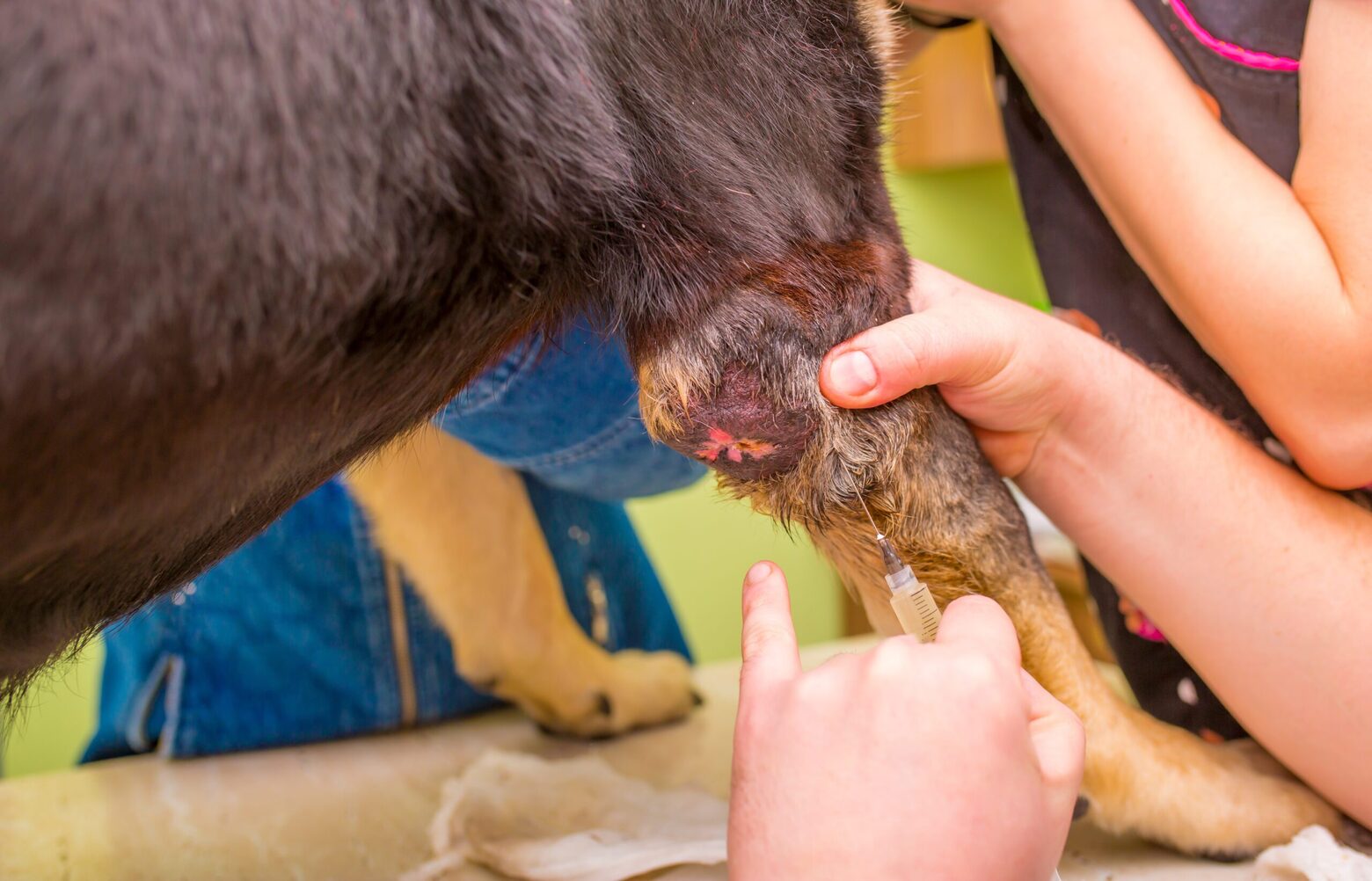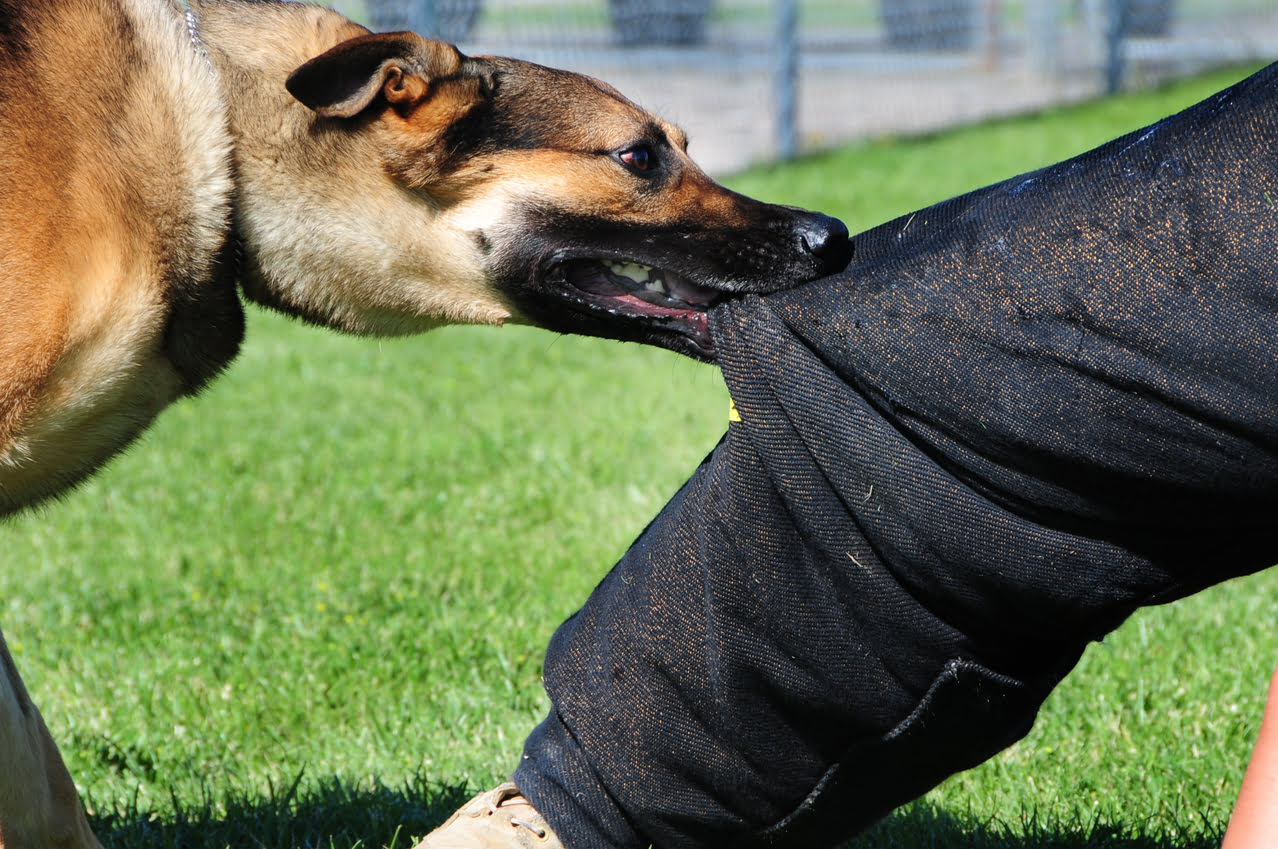Home>Health & Wellness>Common Health Issues>How Soon Can Bone Cancer Develop In A Dog


Common Health Issues
How Soon Can Bone Cancer Develop In A Dog
Published: February 4, 2024
Learn about common health issues in dogs, including how soon bone cancer can develop. Understand the signs, symptoms, and treatment options for your pet's well-being.
(Many of the links in this article redirect to a specific reviewed product. Your purchase of these products through affiliate links helps to generate commission for Pawsomeoldies.com, at no extra cost. Learn more)
Table of Contents
Introduction
Bone cancer, also known as osteosarcoma, is a serious health concern for dogs. This aggressive form of cancer can develop rapidly and significantly impact a dog's quality of life. As a responsible pet owner, it's crucial to be aware of the signs, risk factors, and treatment options associated with bone cancer in dogs.
Understanding the nature of bone cancer and its potential impact on your furry companion is essential for providing timely care and support. By gaining insight into this condition, you can take proactive steps to ensure the well-being of your beloved pet.
In the following sections, we will delve into the intricacies of bone cancer in dogs, exploring the risk factors, signs and symptoms, diagnosis, treatment options, prognosis, and preventive measures. By the end of this comprehensive guide, you will have a deeper understanding of bone cancer in dogs and be better equipped to recognize and address this health issue in your canine companion.
Read more: How Dogs Can Sniff Out Diabetes And Cancer
Understanding Bone Cancer in Dogs
Bone cancer, or osteosarcoma, is a malignant tumor that develops in the bone tissue of dogs. It is one of the most prevalent types of cancer found in canines, particularly in larger breeds. Osteosarcoma typically originates in the long bones of the legs, although it can also affect other bones in the body.
The aggressive nature of bone cancer in dogs is attributed to its ability to rapidly invade and destroy healthy bone tissue. This can lead to severe pain, lameness, and a diminished quality of life for affected dogs. Osteosarcoma is known for its potential to metastasize to other organs, such as the lungs, making early detection and intervention crucial for a positive outcome.
The exact cause of bone cancer in dogs remains unclear, although certain factors, such as genetics and environmental influences, may contribute to its development. Large and giant breeds, including Great Danes, Saint Bernards, and Rottweilers, are more susceptible to osteosarcoma, suggesting a genetic predisposition to this condition. Additionally, older dogs are at a higher risk of developing bone cancer, with the majority of cases occurring in dogs over six years of age.
Understanding the pathology of bone cancer is essential for recognizing its impact on a dog's skeletal system. The tumor disrupts the normal bone structure, leading to weakness, fractures, and pain. As the cancer progresses, affected dogs may exhibit signs of discomfort, reluctance to bear weight on the affected limb, and swelling at the tumor site.
In summary, bone cancer in dogs is a formidable adversary that necessitates vigilance and proactive measures. By comprehending the nature of this disease, pet owners can play a pivotal role in identifying potential symptoms and seeking timely veterinary care. In the subsequent sections, we will explore the risk factors, signs and symptoms, diagnosis, treatment options, prognosis, and preventive strategies associated with bone cancer in dogs.
Risk Factors for Bone Cancer in Dogs
Several factors contribute to the development of bone cancer, or osteosarcoma, in dogs. While the exact cause remains elusive, understanding the potential risk factors can aid in identifying dogs that may be more susceptible to this aggressive disease.
Breed Predisposition
Certain dog breeds have a higher predisposition to developing bone cancer. Large and giant breeds, including Great Danes, Saint Bernards, Rottweilers, and Irish Wolfhounds, are particularly susceptible to osteosarcoma. This suggests a genetic influence on the development of this condition. The rapid growth and larger bone mass in these breeds may contribute to an increased risk of bone cancer.
Age
Age is a significant risk factor for bone cancer in dogs, with the majority of cases occurring in older canines. Osteosarcoma is most commonly diagnosed in dogs over six years of age. As dogs age, their cells may become more susceptible to genetic mutations that can lead to the development of cancerous tumors. Additionally, the cumulative effects of environmental factors over time may contribute to the onset of bone cancer in older dogs.
Read more: Dog Diet: How Much Bone?
Genetics
Genetic predisposition plays a crucial role in the development of bone cancer in dogs. Studies have indicated that certain genetic factors may increase the likelihood of osteosarcoma in specific breeds. The inheritance of genetic mutations associated with bone growth and development may elevate the risk of developing this aggressive form of cancer. Understanding the genetic underpinnings of bone cancer can provide valuable insights into its prevention and early detection.
Environmental Influences
Environmental factors, such as exposure to carcinogens and radiation, may contribute to the development of bone cancer in dogs. While the direct impact of environmental influences on osteosarcoma is not fully understood, minimizing exposure to potential carcinogens and maintaining a healthy living environment for dogs is essential in reducing their risk of developing this disease.
Gender
Some studies have suggested a slight predilection for male dogs in the development of bone cancer. While the reasons for this gender disparity are not fully elucidated, it underscores the importance of monitoring both male and female dogs for potential signs of osteosarcoma.
By recognizing these risk factors, pet owners and veterinarians can work together to identify dogs that may be at a higher risk of developing bone cancer. This awareness can lead to proactive measures, including regular health screenings and preventive care, to mitigate the impact of these risk factors and promote the well-being of canine companions.
Signs and Symptoms of Bone Cancer in Dogs
Identifying the signs and symptoms of bone cancer in dogs is crucial for early detection and prompt intervention. While dogs may exhibit varying degrees of discomfort and physical changes, recognizing potential indicators of osteosarcoma can significantly impact the prognosis and treatment outcomes. Here are the key signs and symptoms to be mindful of:
Read more: How Long Can A Dog Live With Kidney Cancer
Lameness and Limb Pain
One of the primary manifestations of bone cancer in dogs is lameness, often accompanied by persistent limb pain. Affected dogs may display reluctance to bear weight on a specific limb, leading to an altered gait or favoring of the unaffected limbs. The pain associated with bone cancer can be exacerbated by physical activity or palpation of the affected area.
Swelling and Lumps
The presence of swelling or lumps near the affected bone is a common indicator of bone cancer in dogs. The tumor's growth can lead to visible swelling, deformities, or palpable lumps in the vicinity of the affected bone. Pet owners should carefully monitor their dog's skeletal structure for any unusual growths or asymmetries.
Behavioral Changes
Dogs suffering from bone cancer may exhibit behavioral changes indicative of discomfort and distress. This can include increased irritability, restlessness, or a reluctance to engage in activities they previously enjoyed. Behavioral alterations may signal the presence of underlying pain and discomfort associated with bone cancer.
Reduced Mobility
As bone cancer progresses, affected dogs may experience a decline in mobility and overall activity levels. This can manifest as a decreased willingness to engage in physical activities, reluctance to climb stairs or jump, and a general decline in energy and enthusiasm. Observing changes in a dog's mobility and activity patterns is essential for recognizing potential signs of bone cancer.
Fractures and Bone Weakness
The weakened bone structure resulting from osteosarcoma can predispose affected dogs to fractures and bone instability. Fractures may occur spontaneously or as a result of minimal trauma, highlighting the compromised integrity of the bone affected by cancer. Pet owners should be vigilant for any unexplained fractures or signs of bone weakness in their canine companions.
Systemic Symptoms
In advanced cases, bone cancer may lead to systemic symptoms, such as weight loss, loss of appetite, and lethargy. These generalized manifestations can indicate the progression of the disease and its impact on the overall health of the dog.
By remaining attentive to these signs and symptoms, pet owners can play a pivotal role in identifying potential cases of bone cancer in their dogs. Early recognition of these indicators can facilitate timely veterinary evaluation and the implementation of appropriate diagnostic measures and treatment strategies. Regular physical examinations and proactive monitoring of a dog's behavior and physical condition are essential for detecting bone cancer in its early stages, ultimately improving the prognosis and quality of life for affected dogs.
Diagnosis and Treatment Options
Diagnosing bone cancer in dogs involves a comprehensive approach that encompasses clinical evaluations, imaging studies, and, in some cases, tissue sampling. Upon suspecting bone cancer based on the dog's clinical presentation and physical examination findings, veterinarians may employ various diagnostic modalities to confirm the diagnosis and formulate an appropriate treatment plan.
Diagnostic Procedures
Radiography and Imaging Studies
Radiographs, or X-rays, play a pivotal role in the initial assessment of suspected bone cancer in dogs. These imaging studies can reveal characteristic changes in the affected bone, such as bone destruction, new bone formation, and soft tissue swelling. Additionally, advanced imaging modalities, including computed tomography (CT) and magnetic resonance imaging (MRI), may be utilized to provide detailed insights into the extent of bone involvement and the presence of metastatic lesions.
Biopsy
In cases where the diagnosis remains inconclusive based on imaging studies alone, a biopsy of the affected bone or surrounding tissue may be recommended. Tissue sampling allows for histopathological examination, enabling the identification of cancerous cells and the determination of the specific type and grade of the tumor. This information is crucial for devising an effective treatment strategy tailored to the individual dog's condition.
Read more: How Long Can A Dog Live With Skin Cancer
Treatment Options
Surgical Intervention
Surgery is a cornerstone of treatment for localized bone cancer in dogs. The primary objective of surgical intervention is to achieve complete excision of the cancerous bone, which may involve limb amputation or limb-sparing procedures. Limb-sparing surgeries aim to remove the affected bone while preserving the limb's function through the use of prosthetic implants or bone grafts. The decision regarding the type of surgical approach is influenced by the tumor's location, size, and the dog's overall health status.
Chemotherapy
Following surgical resection of the primary tumor, chemotherapy is often recommended to target potential metastatic disease and residual cancer cells. Chemotherapeutic agents, administered either intravenously or orally, aim to impede the spread of cancer and reduce the likelihood of disease recurrence. While chemotherapy may present certain side effects, including gastrointestinal upset and bone marrow suppression, it plays a crucial role in improving the long-term prognosis for dogs with bone cancer.
Palliative Care
In cases where surgical intervention is not feasible or in instances of advanced disease, palliative care strategies may be employed to alleviate pain and improve the dog's quality of life. This may involve the use of pain management medications, supportive care measures, and physical therapy to enhance mobility and comfort for affected dogs.
Ongoing Monitoring and Support
Following the initiation of treatment, ongoing monitoring and supportive care are essential components of managing bone cancer in dogs. Regular veterinary examinations, imaging studies, and laboratory tests are employed to assess treatment response, monitor for potential complications, and provide supportive interventions as needed.
In summary, the diagnosis and treatment of bone cancer in dogs necessitate a multidisciplinary approach, encompassing diagnostic precision, surgical expertise, and comprehensive supportive care. By leveraging these diagnostic and treatment options, veterinarians strive to optimize the prognosis and quality of life for dogs affected by this challenging disease.
Prognosis and Survival Rates
The prognosis for dogs diagnosed with bone cancer, or osteosarcoma, is influenced by various factors, including the extent of disease, response to treatment, and the overall health status of the affected canine. While osteosarcoma is known for its aggressive nature, advancements in diagnostic techniques and treatment modalities have contributed to improved prognostic outcomes and enhanced survival rates for dogs facing this formidable disease.
The primary determinant of prognosis in dogs with bone cancer is the presence or absence of metastasis, particularly to the lungs. Osteosarcoma has a propensity for metastasizing to the lungs, which can significantly impact the overall prognosis. Dogs with localized bone cancer, where the disease is confined to the primary site without evidence of metastatic spread, have a more favorable prognosis. In such cases, aggressive surgical intervention, often coupled with adjuvant chemotherapy, can yield promising outcomes, with a median survival time ranging from 10 to 12 months.
For dogs with evidence of metastatic disease, the prognosis becomes more guarded, as the presence of distant spread necessitates a comprehensive approach to target both the primary tumor and metastatic lesions. Despite the challenges posed by metastatic osteosarcoma, advancements in chemotherapy protocols and supportive care measures have contributed to extending survival times and enhancing the quality of life for affected dogs. With diligent monitoring and tailored treatment strategies, some dogs with metastatic bone cancer may achieve a median survival time of 6 to 12 months, providing valuable time for cherished moments with their families.
The response to treatment, particularly surgical resection of the primary tumor and adjuvant chemotherapy, plays a pivotal role in shaping the prognosis for dogs with bone cancer. Achieving complete excision of the primary tumor, whether through limb amputation or limb-sparing procedures, is associated with improved survival rates and a reduced risk of disease recurrence. Additionally, the implementation of effective chemotherapy regimens, tailored to the individual dog's condition, can further enhance the likelihood of disease control and long-term remission.
It is important to note that while prognostic factors and survival rates provide valuable insights, each dog's response to treatment and disease trajectory is unique. The dedication of pet owners and the collaborative efforts of veterinary professionals are instrumental in navigating the challenges posed by bone cancer and striving to optimize the quality of life for affected dogs. By leveraging advancements in veterinary oncology and providing compassionate care, the prognosis for dogs with bone cancer continues to evolve, offering hope and support to canine companions and their devoted families.
Prevention and Early Detection of Bone Cancer in Dogs
Preventing bone cancer in dogs involves a multifaceted approach that encompasses proactive measures to mitigate potential risk factors and promote overall canine health. While certain predisposing factors, such as breed predisposition and genetics, may be beyond direct control, pet owners can take several steps to minimize the likelihood of bone cancer and facilitate early detection.
Read more: Which Dogs Can Sense Cancer
Weight Management and Nutrition
Maintaining a healthy body weight is crucial for reducing the risk of bone cancer in dogs, particularly in large and giant breeds. Excess body weight can exert undue stress on the skeletal system, potentially predisposing dogs to orthopedic conditions, including bone cancer. By providing a balanced diet and regular exercise, pet owners can support their canine companions' overall well-being and minimize the impact of obesity-related health concerns.
Environmental Awareness
Creating a safe and nurturing environment for dogs involves minimizing exposure to potential carcinogens and toxins. This includes avoiding prolonged contact with environmental pollutants, such as secondhand smoke, industrial chemicals, and herbicides. Additionally, ensuring a clean and hazard-free living space can contribute to a healthier lifestyle for dogs, reducing the potential impact of environmental influences on their health.
Regular Veterinary Care and Monitoring
Routine veterinary examinations and preventive care play a pivotal role in the early detection of bone cancer in dogs. Pet owners should prioritize regular wellness visits, allowing veterinarians to conduct thorough physical examinations and assess the dog's overall health. Through proactive monitoring, potential signs of bone cancer, such as lameness, swelling, or behavioral changes, can be identified at an early stage, facilitating prompt diagnostic evaluation and intervention.
Breed-Specific Screening
For breeds with a known predisposition to bone cancer, such as Great Danes and Rottweilers, breed-specific screening and genetic testing may offer valuable insights into the dog's susceptibility to this condition. By collaborating with veterinarians and leveraging advancements in genetic screening, pet owners can gain a deeper understanding of their dog's genetic profile and potential health risks, empowering them to take proactive measures to mitigate these concerns.
Education and Awareness
Raising awareness about the signs and symptoms of bone cancer in dogs is essential for empowering pet owners to recognize potential indicators and seek timely veterinary care. Educational initiatives, including informational resources and community outreach, can equip dog owners with the knowledge and tools to monitor their canine companions for any changes in behavior, mobility, or physical condition that may warrant veterinary attention.
By embracing these preventive strategies and fostering a proactive approach to canine health, pet owners can play a pivotal role in mitigating the impact of bone cancer in dogs. Early detection, coupled with a commitment to overall well-being, is instrumental in safeguarding the health and vitality of canine companions, offering them the opportunity to lead fulfilling and vibrant lives.
Conclusion
In conclusion, bone cancer, or osteosarcoma, presents a formidable challenge for dogs and their devoted owners. This aggressive form of cancer can significantly impact a dog's quality of life, necessitating vigilance, proactive measures, and compassionate care. By delving into the intricacies of bone cancer in dogs, we have gained valuable insights into its nature, risk factors, signs and symptoms, diagnosis, treatment options, prognosis, and preventive strategies.
Understanding the risk factors associated with bone cancer, including breed predisposition, age, genetics, environmental influences, and gender, provides a foundation for identifying dogs that may be more susceptible to this condition. By recognizing these risk factors, pet owners and veterinarians can collaborate to implement preventive measures and proactive monitoring, ultimately striving to mitigate the impact of bone cancer on canine companions.
The signs and symptoms of bone cancer in dogs serve as crucial indicators for early detection and intervention. By remaining attentive to lameness, limb pain, swelling, behavioral changes, reduced mobility, and systemic symptoms, pet owners can play a pivotal role in identifying potential cases of bone cancer in their dogs. Early recognition of these indicators facilitates timely veterinary evaluation and the implementation of appropriate diagnostic measures and treatment strategies, ultimately improving the prognosis and quality of life for affected dogs.
The diagnosis and treatment of bone cancer in dogs necessitate a multidisciplinary approach, encompassing diagnostic precision, surgical expertise, and comprehensive supportive care. Leveraging diagnostic modalities such as radiography, imaging studies, and biopsies, veterinarians strive to confirm the diagnosis and formulate tailored treatment plans to address the individual needs of affected dogs.
Prognosis and survival rates for dogs with bone cancer are influenced by various factors, including the extent of disease, response to treatment, and the overall health status of the affected canine. While osteosarcoma poses significant challenges, advancements in diagnostic techniques, treatment modalities, and ongoing supportive care have contributed to improved prognostic outcomes and enhanced survival rates for dogs facing this formidable disease.
Preventing bone cancer in dogs involves a multifaceted approach, encompassing proactive measures to mitigate potential risk factors and promote overall canine health. By prioritizing weight management, environmental awareness, regular veterinary care, breed-specific screening, and education, pet owners can play a pivotal role in safeguarding the health and vitality of their canine companions, offering them the opportunity to lead fulfilling and vibrant lives.
In essence, the journey of navigating bone cancer in dogs underscores the resilience, compassion, and unwavering commitment of pet owners and veterinary professionals. By fostering a collaborative and proactive approach to canine health, we can strive to mitigate the impact of bone cancer and provide cherished companions with the care, support, and hope they deserve.









